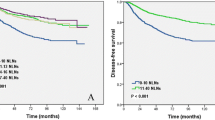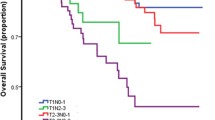Abstract
Background
The aim of the present study was to determine how lymph node ratio (LNR; the ratio of the number of metastatic lymph nodes to the number of removed lymph nodes) can supplement the TNM nodal classification in breast carcinoma.
Methods
We retrospectively reviewed the file records of 2,151 patients.
Results
Lymph node ratio-based low- (LNR ≤ 0.20), intermediate- (LNR 0.21–0.65), and high-risk (LNR > 0.65) patient groups had significantly different disease-free survival (DFS) (P < 0.001). The DFS of patients with N1, N2, and N3 disease was significantly different (P < 0.001). When LNR and TNM nodal groupings were included together in the Cox analysis, both groupings had independent prognostic significance (P < 0.001 and P < 0.001, respectively). The most significant LNR threshold value separating patients in low-risk and high-risk groups in terms of disease recurrence was 0.20 for N1 disease (P < 0.001), 0.35 for N2 disease (P < 0.001), and 0.90 for N3 disease (P < 0.001).
Conclusions
Lymph node ratio and TNM nodal groupings show no superiority over each other in categorizing patients with node-positive breast carcinoma into prognostic groups of low-, intermediate-, and high-risk. However, LNR grouping may supplement TNM nodal classification by categorizing patients within each TNM nodal group into low-risk and high-risk groups with significantly different survival.





Similar content being viewed by others
References
Nemoto T, Vana J, Bedwani RN et al (1980) Management and survival of female breast cancer: results of a national survey by the American College of Surgeons. Cancer 45:2917–2924
Fisher B, Bauer M, Wickerham DL et al (1983) Relation of number of positive axillary nodes to the prognosis of patients with primary breast cancer: an NSABP update. Cancer 52:1551–1557
Vinh-Hung V, Burzykowski T, Cserni G et al (2003) Functional form of the effect of the numbers of axillary nodes on survival in early breast cancer. Int J Oncol 22:697–704
Edge SB, Byrd DR, Compton CC et al (2010) AJCC cancer staging handbook, 7th edn. Springer, New York
Kutiyanawala MA, Sayed M, Stotter A et al (1998) Staging the axilla in breast cancer: an audit of lymph-node retrieval in one U.K. regional centre. Eur J Surg Oncol 24:280–282
Iyer RV, Hanlon A, Fowble B et al (2000) Accuracy of the extent of axillary nodal positivity related to primary tumor size, number of involved nodes, and number of nodes examined. Int J Radiat Oncol Biol Phys 47:1177–1183
Schaapveld M, Otter R, de Vries EGE et al (2004) Variability in axillary lymph node dissection for breast cancer. J Surg Oncol 87:4–12
Fortin A, Dagnault A, Blondeau L et al (2006) The impact of the number of excised axillary nodes and of the percentage of involved nodes on regional nodal failure in patients treated by breast-conserving surgery with or without regional irradiation. Int J Radiat Oncol Biol Phys 65:33–39
Schaapveld M, de Vries EGE, van der Graaf WTA et al (2006) The prognostic effect of the number of histologically examined axillary lymph nodes in breast cancer: stage migration or age association? Ann Surg Oncol 13:465–474
Kuru B (2006) Prognostic significance of total number of nodes removed, negative nodes removed, and ratio of positive nodes to removed nodes in node positive breast carcinoma. Eur J Surg Oncol 32:1082–1088
Kuru B, Bozgul M (2006) The impact of axillary lymph nodes removed in staging of node-positive breast carcinoma. Int J Radiat Oncol Biol Phys 66:1328–1334
Danish Breast Cancer Cooperative Group, Axelsson CK, Mouridsen HT, Düring M et al (2007) Axillary staging during surgery for breast cancer. Br J Surg 94:304–309
Cil T, Hauspy J, Kahn H et al (2008) Factors affecting axillary lymph node retrieval and assessment in breast cancer patients. Ann Surg Oncol 15:3361–3368
Bembenek A, Schlag PM (2000) Lymph-node dissection in breast cancer. Langenbeck’s Arch Surg 385:236–245
Petrik DW, McCready DR, Sawka CA et al (2003) Association between extent of axillary lymph node dissection and patient, tumor, surgeon, and hospital factors in patients with early breast cancer. J Surg Oncol 82:84–90
Truong PT, Olivotto IA, Whelan TJ et al (2004) Clinical practice guidelines for the care and treatment of breast cancer: 16. Locoregional post-mastectomy radiotherapy. Can Med Assoc J 170:1263–1273
Voordeckers M, Vinh-Hung V, Van de Steene J et al (2004) The lymph node ratio as prognostic factor in node-positive breast cancer. Radiother Oncol 70:225–230
Costa LJM, Soares HP, Gaspar HA et al (2004) Ratio between positive lymph nodes and total dissected axillaries lymph nodes as an independent prognostic factor for disease-free survival in patients with breast cancer. Am J Clin Oncol 27:304–306
Yildirim E, Berberoglu U (2007) Lymph node ratio is more valuable than level III involvement for prediction of outcome in node-positive breast carcinoma patients. World J Surg 31:276–289
Vinh-Hung V, Verkooijen HM, Fioretta G et al (2009) Lymph node ratio as an alternative to pN staging in node-positive breast cancer. J Clin Oncol 27:1062–1068
Danko ME, Bennett KM, Zhai J et al (2010) Improved staging in node-positive breast cancer patients using lymph node ratio: results in 1,788 patients with long-term follow-up. J Am Coll Surg 210:797–807
Schiffman SC, McMasters KM, Scoggins CR et al (2011) Lymph node ratio: a proposed refinement of current axillary staging in breast cancer patients. J Am Coll Surg 213:45–53
Chagpar AB, Camp RL, Rimm DL (2011) Lymph node ratio should be considered for incorporation into staging for breast cancer. Ann Surg Oncol 18:3143–3148
Ibrahim EM, Elkhodary TR, Zekri JM et al (2010) Prognostic value of lymph node ratio in poor prognosis node-positive breast cancer patients in Saudi Arabia. Asia Pac J Clin Oncol 6:130–137
Vinh-Hung V, Joseph SA, Coutty N et al (2010) Age and axillary lymph node ratio in postmenopausal women with T1–T2 node positive breast cancer. Oncologist 15:1050–1062
Woodward WA, Vinh-Hung V, Ueno NT et al (2006) Prognostic value of nodal ratios in node-positive breast cancer. J Clin Oncol 24:2910–2916
Ustaalioglu BBO, Bilici A, Kefeli U et al (2010) Does the metastatic lymph node ratio influence the disease-free survival of patients with breast cancer: single-center experiences. Oncology 79:105–111
Martinez-Ramos D, Escrig-Sos J, Alcalde-Sanchez M et al (2009) Disease-free survival and prognostic significance of metastatic lymph node ratio in T1–T2 N positive breast cancer patients. A population registry-based study in a European country. World J Surg 33:1659–1664
Atahan IL, Yildiz F, Ozyigit G et al (2008) Percent positive axillary lymph node metastasis predicts survival in patients with non-metastatic breast cancer. Acta Oncol 47:232–238
Atahan İL, Ozyigit G, Yildiz F et al (2008) Percent positive axillary involvement predicts for the development of brain metastasis in high-risk patients with nonmetastatic breast cancer receiving post-mastectomy radiotherapy. Breast J 14:245–249
Tai P, Joseph K, Sadikov E et al (2007) Nodal ratios in node-positive breast cancer—long-term study to clarify discrepancy of role of supraclavicular and axillary regional radiotherapy. Int J Radiat Oncol Biol Phys 68:662–666
Duraker N, Batı B, Demir D et al (2011) Prognostic significance of the number of removed and metastatic lymph nodes and lymph node ratio in breast carcinoma patients with 1–3 axillary lymph node(s) metastasis. ISRN Oncol 2011:645450. doi:10.5402/2011/645450
Duraker N, Çaynak ZC, Batı B (2008) Is there any prognostically different subgroup among patients with stage IIIC (anyTN3M0) breast carcinoma? Ann Surg Oncol 15:430–437
Yildirim E, Berberoglu U (2007) Local recurrence in breast carcinoma patients with T 1–2 and 1–3 positive nodes: indications for radiotherapy. Eur J Surg Oncol 33:28–32
Truong PT, Woodward WA, Thames HD et al (2007) The ratio of positive to excised nodes identifies high-risk subsets and reduces inter-institutional differences in locoregional recurrence risk estimates in breast cancer patients with 1–3 positive nodes: an analysis of prospective data from British Columbia and the M.D. Anderson Cancer Center. Int J Radiat Oncol Biol Phys 68:59–65
Truong PT, Berthelet E, Lee J et al (2005) The prognostic significance of the percentage of positive/dissected axillary lymph nodes in breast cancer recurrence and survival in patients with one to three positive axillary lymph nodes. Cancer 103:2006–2014
Walker MJ, Osborne MD, Young DC et al (1995) The natural history of breast cancer with more than 10 positive nodes. Am J Surg 169:575–579
German Breast Cancer Study Group (GBSG), Schmoor C, Sauerbrei W, Bastert G et al (2001) Long-term prognosis of breast cancer patients with 10 or more positive lymph nodes treated with CMF. Eur J Cancer 37:1123–1131
Conflict of interest
None.
Author information
Authors and Affiliations
Corresponding author
Rights and permissions
About this article
Cite this article
Duraker, N., Batı, B., Çaynak, Z.C. et al. Lymph Node Ratio May Be Supplementary to TNM Nodal Classification in Node-positive Breast Carcinoma Based on the Results of 2,151 Patients. World J Surg 37, 1241–1248 (2013). https://doi.org/10.1007/s00268-013-1965-1
Published:
Issue Date:
DOI: https://doi.org/10.1007/s00268-013-1965-1




